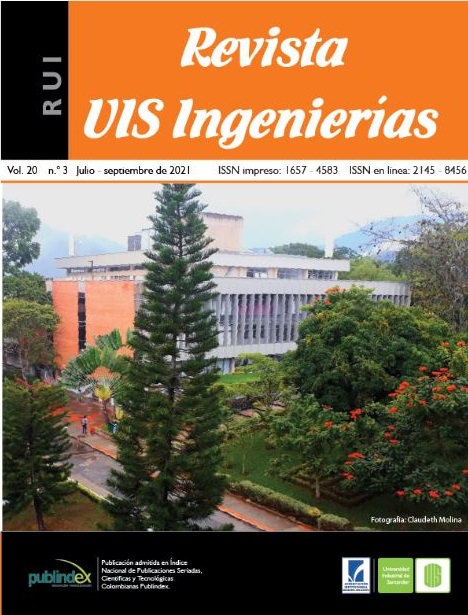Non-domestic wastewater management (ARnD) using a geographic information system in the definition of sanitary districts
Published 2021-06-05
Keywords
- geographic information system (GIS),
- water quality,
- sewage discharge,
- classification of special zones,
- pressur-heat maps
- water resource management ...More
How to Cite
Abstract
Thanks to the extensive knowledge that we have at Empresas Públicas de Medellin, about the wastewater problem r in Aburrá Valley, La Doctora basin located in the municipality of Sabaneta - Antioquia was chosen as a particular study area for the application of pressure areas due to discharges (charge and flow volumes). The basin is described as a space in which special characteristics coexist as follows: a high area (rural), an intermediate area (combined between current homes and new development of these, plus an industrial trade), and finally, a low area, with high diverse industrial activity. With this research, it was possible to differentiate special areas associated with components of pressure by the resource and volume of wastewater discharge, which allowed proposing three different sanitary districts. The first one for domestic wastewater (DS-ARD), the second one for water combined wastewater (DS ARD-ARnD), and the third one, for non-domestic wastewater (DS ARnD). The study required the application of the EPM service operator's information, statistical tools, correlation matrices for flow and pollutant load, self-declaration information for discharges, field sampling, and the use of ArcGIS software. It is expected that this tool, which has a broad statistical component, can be adopted by environmental entities to improve management, planning and serve as an alternative to decentralized treatment of wastewater.
Downloads
References
[2] J. Paavola, “Sewage Pollution and Institutional and Technological Cange in the United States, 1830-1915”, Ecological Economics, vol. 69, no. 12, pp. 2517-2524, 2010, doi: 10.1016/j.ecolecon.2010.07.028
[3] S. Tongesayi, T. Tongesayi, “Chapter Seventeen - Water Quality and Public Health: Role of Wastewater”, en Chemistry and Water The Science Behind Sustaining the World's Most Crucial Resource, West Long Branch, NJ, USA: El Sevier, 2017, pp. 553-596, doi: 10.1016/B978-0-12-809330-6.00017-9
[4] R. K.Sharma, M. Yadav, R. Gupta, “Chapter Five - Water Quality and Sustainability in India: Challenges and Opportunities”, en Chemistry and Water The Science Behind Sustaining the World's Most Crucial Resource, West Long Branch, NJ, USA: El Sevier, 2017, pp. 183-205, doi: 10.1016/B978-0-12-809330-6.00005-2
[5] A. S. Tanner, B. S. Mcintosh, D.C.C. Widdowon, M.R. Tillstson, “The water Utility Adoption Model (wUAM): Understanding Influences of organisaional and procedural innovation in a UK water utility”, Journal of Cleaner Production, vol. 171, pp. 586-596, 2018, doi: 10.1016/j.jclepro.2016.06.176
[6] Ş. Delipınar, M. Karpuzcu, “Policy, legislative and institutional assessments for integrated river basin management in Turkey”, Environmental Science & Policy., vol 72, pp. 20-29, 2017, doi: 10.1016/j.envsci.2017.02.011
[7] U. When, C. Montalvo, “Exploring the dynamics of water innovation: Foundations for water innovation studies”, Journal of Cleaner Production, vol. 171, pp. 1-19, 2018, doi: 10.1016/j.jclepro.2017.10.118
[8] S. M. Praveenaa, A. Zaharin Arisb, “A baseline study of tropical coastal water quality in Port Dickson, Strait of Malacca”, Marine Pollution Bulletin, vol. 67, no. 1-2, pp. 196-199, 2012, doi: 10.1016/j.marpolbul.2012.11.037
[9] X. Wang, J. Zhang, V. Babovic, “Improving real-time forecasting of water quality indicators with combination of process-based models and data assimilation technique”, Ecological Indicators., vol. 66, pp. 428-439, 2016, doi: 10.1016/j.ecolind.2016.02.016
[10] C. Granados, E. Sánchez, “Water Reforms, Descentralización and Child Mortality in Colombia, 1990–2005”, World Development, vol 53, pp. 68-79, 2014, doi: 10.1016/j.worlddev.2013.01.007
[11] Resolución 0075 de 2011. Por la cual se adopta el formato de reporte sobre el estado de cumplimiento de la norma de vertimiento puntual al alcantarillado público. [En línea]. Disponible en: https://www.minambiente.gov.co/images/GestionIntegraldelRecursoHidrico/pdf/normativa/Res_0075_de_2011.pdf.
[12] Decreto 2667 de 2012. Por el cual se reglamenta la tasa retributiva por la utilización directa e indirecta del agua como receptor de vertimientos puntuales, y se toman otras determinaciones. [En línea]. Disponible en: https://www.funcionpublica.gov.co/eva/gestornormativo/norma.php?i=51042.
[13] Resolución 0631 de 2015. Por la cual se establecen los parámetros y valores máximos permisibles en los vertimientos a los cuerpos de agua superficiales y a los sistemas de alcantarillado público. [En línea]: Disponible en:https://www.leyex.info/leyes/Resolucionmads631de2015.pdf.
[14] Decreto 1076. Por medio del cual se expide el Decreto Único Reglamentario del Sector Ambiente y Desarrollo Sostenible. [En línea]: Disponible en: https://www.funcionpublica.gov.co/eva/gestornormativo/norma_pdf.php?i=78153.
[15] ArcGis Pro, “Obtenido de Análisis de clúster y de valor atípico (I Anselin local de Moran)”, ESRI. [En línea]. Disponible en: https://pro.arcgis.com/es/pro-app/tool-reference/spatial-statistics/cluster-and-outlier-analysis-anselin-local-moran-s.htm.
[16] E. W. Rice, R. B. Baird, A. D. Eaton, Standard Methods For the Examination of Water and Wastewater, 23nd edition. USA: American Public Health Association, American Water Works Association, Water Environment Federation, 2017.
[17] Protocolo de monitoreo del agua, Instituto de Hidrología, Meteorología y Estudios Ambientales, 2017. [En línea]. Disponible en: http://documentacion.ideam.gov.co/openbiblio/bvirtual/023773/protocolo_monitoreo_agua_ideam.pdf
[18] H. Chen, X. Cui, R. Long, T. Yang, D. Zhu, “Application of the public–private partnership model to urban sewage treatment”, Journal of Cleaner Production, vol. 142, no. 2, pp. 1065-1074, 2016, doi: 10.1016/j.jclepro.2016.04.152


